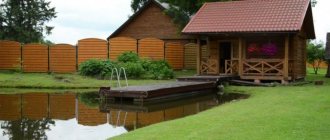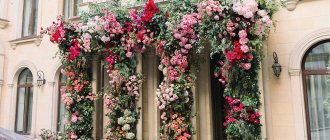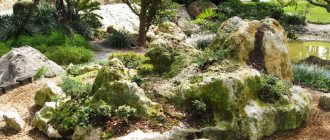A dacha is not only a place where fruits and vegetables are grown, but also an opportunity to escape from problems and communicate with nature. Therefore, most summer residents try to create all kinds of places for relaxation on their plots.
A Japanese garden can be a stylish and unusual place to relax. It does not require a lot of space, 5-7 m2 is enough. Armed with information about creating a Japanese-style garden with your own hands and with a little effort, you can get a magical corner for relaxation and rest.
Advantages and features of a Japanese garden
A Japanese-style garden is distinguished by a harmonious combination of plants and architectural objects. It does not have the artificial symmetry that is typical of landscaped areas. Here nature shows all its natural beauty, undergoing virtually no changes. The combination of stones, water and plants creates a unique design, each element of which is filled with deep meaning.
Japanese garden with flowering plants Source gd-home.com
When creating a garden, it is necessary to correctly identify all natural elements. In Japanese philosophy, stones are the skeleton of the landscape, and water symbolizes its blood. The design can be complemented by bamboo fences, small bridges, gazebos, lanterns, gates and bells. Such elements create a cozy atmosphere and add a special oriental flavor to it.
In temperate climates, plants that are accustomed to local conditions should be planted. The reservoirs have natural smooth outlines, without traces of artificial intervention. In such a landscape, calm and tranquility reign, characteristic of oriental gardens.
Japanese garden with a pond Source portes.ua
It is better not to use fountains on the site at all. They should be replaced with waterfalls, which look more natural in this style. If the garden is small in size, then there is no need to place large boulders and wide benches under huge trees on its territory. Multi-colored elements will also disrupt the harmony of the design, which suggests maximum resemblance to the untouched natural environment. The main color of the territory must be green; some small accents of other shades are allowed.
Pond made of stones in the garden Source brd24.com
Distinctive features of Japanese landscape design
The style of an oriental garden is determined by the nature of the state of Japan, more than half of whose area is occupied by mountainous areas. The landscapes are dominated by rocks, mountain streams, lakes, and the seashore. The elements of water, stone and plants predominate here.
Therefore, Japan is characterized by a muted color scheme of gray-brown and greenish tones. Floral elements complement the picture; this is the philosophical principle of non-interference in nature. Nature itself is beautiful and harmonious. It doesn't need decoration.
The area of a Japanese green corner is often small, but all elements are carefully thought out. Photo example:
You may be interested in: How to design a garden in Art Nouveau style: choosing plants, trees, bushes and flowers
Types of design
Japanese style in landscape design is represented by 4 options for implementing the direction:
- Tsubo is a small area of a yard or building with an open roof.
- A rock garden is a space without vegetation. It is quite easy to decorate, but may not be decorative enough.
- The tree garden is a kind of park area, which is characterized by maximum naturalness and changes according to the seasons.
- A tea garden is a combination of two types of vegetation with different designs. In shaded areas, a special pavilion must be set up for traditional tea ceremonies.
Tsubo
This garden dates back to the Middle Ages, when the architecture of Japanese cities was just developing. The name comes from the word “tsubo”, which means a small area of about 3 m2. The composition can be placed both indoors and within the main landscape.
A small piece of nature is designed to enliven urban housing and decorate cramped spaces. Plants are planted according to the cardinal direction. It is better to decorate the northern areas with various mosses, since they are not suitable for heat-loving plantings.
The main space of the tsubo is occupied by stones, leaving a tiny area for vegetation. The center of the composition is made up of trees, which are selected to match the overall design of the home. A similar garden can be arranged in a country house - all you need to do is install a tsukubai lantern, lay stone paths and plant a small number of plants.
You can enhance the lighting with the help of lamps, lanterns and mirror surfaces. Thus, the space will acquire a special oriental atmosphere of warmth and harmony.
House with tsubo Source web-sad.ru
Music of Japanese garden stones
In Eastern philosophy, stones symbolize stability and vitality. Placers of cobblestones are a reflection of the vast, endless Universe, which cannot be quickly known and studied. Stones must be placed in the garden in such a way that only a few of them are visible from any point in the area. The quantity must be an odd number.
Stones in a Japanese garden Source dobrostroy.house
The stones in the composition are always laid diagonally from the left corner of the accessible area. The colors of the cobblestones should be similar; you can create groups of different shades. The only condition is that the stones cannot be processed, they remain in their natural form. Over time, natural objects will become covered with moss, which will give them a more natural and attractive appearance. The size of the stones does not matter; you can alternate between small stones and massive boulders. Among the composition, trees with bright leaves and unusual shrubs will look great.
Compositions made of stones Source diz-cafe.com
Japanese landscape design creates a calm, peaceful atmosphere that is filled with harmony and provides excellent opportunities for contemplation and reflection. Winding stone paths invite the visitor to wander among untouched nature and enjoy the natural beauty of plants. Paths can be very different - paved with flat stones with a smooth surface, which symbolize the path of life without obstacles, or paths made of gravel, sandstone or pebbles. These materials can replace water bodies; dry streams or small waterfalls are created from them.
Stream of stones Source roomester.ru
Objects in the garden are placed according to strict rules, violation of which threatens the loss of harmony. The main stone is located in the center of the composition, and the remaining elements complement the design and symbolize the features of the relief. Cobblestones can be designed in the form of islands or mountain systems, it all depends on the designer’s imagination.
The stones should not be placed in strict sequence, since symmetry is not welcome here. Objects from rivers, mountains and seas do not combine in one area. To ensure a stable position of the cobblestones, you can dig them in a little. To disguise the flaws of boulders, small shrubs and herbaceous plants are planted next to them. They should be wild and inexpressive shades.
Plants near a pond made of stones Source greenhome.kz
Design Features
To ensure that your efforts are not in vain, and that your own garden truly embodies oriental culture, we recommend adhering to the following design principles characteristic of Japanese gardens:
- the design of such a site should be asymmetrical: this is the only way you can emphasize the naturalness and naturalness of the decor;
- Every element of a Japanese garden must be planned. You should not decorate it with inappropriate accessories and details that do not carry any meaning;
- do not decorate the Japanese garden with too bright and flashy plants and stones. But they should attract attention due to their location and their clear round shape;
- The ground around the vegetation elements of the Japanese garden should be compacted or covered with small gravel. Increasingly, lawn grass has begun to be used for surrounding decoration, but in this case it should be ensured that individual bushes or stone decorations are found on such a surface: this is also considered a distinctive feature of Japanese design;
- green spaces should not be located too closely to each other. It is better to leave free space between plants. The abundance of trees, flower arrangements and flower beds is not typical for Japanese gardens, so you should not bring chaos to the landscape design.
Plants in a Japanese garden
A large number of green spaces can be found in a tree garden, which is one of the varieties of Japanese landscape design. In such an area, an atmosphere of natural forest space is created, which necessarily has ponds and a lot of fresh air. The appearance of the site is reminiscent of European park areas, and therefore it is most familiar to a resident of the middle zone. Trees in a Japanese garden are planted both deciduous and coniferous in order to maintain flowering plants in any season of the year.
Japanese garden in autumn Source pinterest.com
Boxwood, rhododendron and dogwood bushes will perfectly complement the space. They can be trimmed and used to camouflage buildings and structures in the country, or you can decorate the walls of your home with neat bushes. River and steppe landscapes also look great against the background of the rounded tops of bushes.
One of the important features of a Japanese-style garden is the presence of a large number of decorative elements that complement the landscape design. These can be fences, bridges, lanterns and gates. Internal partitions are made light and transparent. The materials for them are often wood and bamboo. It is preferable to make external barriers of stone and decorate them with tiles.
Plants in the garden must be positioned in such a way that trees that are fading are immediately replaced by trees that are blooming. The purpose of a Japanese-style landscape is to symbolically represent the entire world, so low shrubs also play an important role here. Juniper, rhododendron and dwarf fir trees harmoniously combine with spreading oaks and tall pines. Fruit trees are perfect for such a garden; they will allow you to admire the blossoms in the spring season. Apricots or cherries are not inferior in beauty to the famous Japanese sakura, so you can safely plant them on your site.
It is preferable to choose herbaceous plants with large leaves. Well suited: fern, Rogersia, chrysanthemum. If you want to bring the look of the garden as close as possible to Japanese territories, then you can complement the design with bamboo and bonsai in pots.
Since in the Eastern tradition each plant is endowed with a special meaning, it is worth paying attention to the meaning of certain plantings:
- pine is a symbol of longevity, courage and sustainable principles;
- willow symbolizes modesty and humility;
- plum tree means spiritual beauty;
- maple means knowledge and wisdom;
- bamboo symbolizes determination and perseverance;
- bindweed represents poetic talent;
- moss and lichen mean care and mercy.
When choosing plants for a site, you must pay attention to these points.
Stage three. Choosing vegetation for the garden
Another important element in this case is plants. In the middle zone, as you know, the climate is quite harsh, so creating a fragrant flower garden, like in Japan, is impossible. Our garden will be more ascetic. When choosing plants for your site, avoid bright and large flowers. It is better to use green plants with small leaves and inconspicuous flowers. But if you want to stand out from the general background, you can use bonsai or dwarf plants; besides, climbing vegetation that flows down will look great. To decorate Japanese gardens, you can use almost any coniferous crop, combining it with ground cover vegetation and creeping bushes.
Note! In a separate area of the site, you can create a so-called moss garden, which will organically fit into the overall composition and only complement its naturalness.
Pay special attention to ensuring that the shape of all plants is approximately the same. Thanks to such uniformity, you will achieve harmony, and people who visit your Japanese garden will experience extremely positive emotions. A competent choice of frost-resistant vegetation will guarantee that the garden will not freeze in winter, and with the onset of spring it will begin to delight again with its magnificent landscapes.
Small architectural forms in a Japanese garden
The oriental style personifies the serenity and beauty of nature, which harmoniously combines with the human home. The surrounding space is designed to inspire people to contemplate and reflect. The same purpose is served by various decorative elements that symbolize important parts of the Universe.
Since stones play a significant role in the Japanese garden, the most successful solution would be to create structures and sculptures from this natural material. Small wooden pagodas will create an oriental flavor and turn into a design highlight. Low lanterns along the paths combine perfectly with laconic stone benches. The ringing bells on the branches of the trees will ring from gusts of wind and evoke peace. Decorations should be present only in small quantities so as not to disturb the harmony of nature.
Content
- History of origin
- How is a Japanese garden different?
- Principles of creating a Japanese garden
- Stage one. Layout of a Japanese garden on a country plot
- Stage two. Choosing stones for a Japanese garden
- Stage three. Choosing vegetation for the garden
- Stage four. Consider additional elements
- Stage five. Japanese garden lighting
- Practical advice. Proper creation of a Japanese garden
- Photo – Japanese Garden
Interesting fact! Do you know how a Japanese garden differs from a Chinese one? If not, we recommend reading this article!
Bridges in Japanese traditions
In the European understanding, bridges have a purely utilitarian purpose; they are located above obstacles for convenient crossing. In Japanese gardens, these buildings are decorative elements with hidden meaning. In Eastern philosophy, bridges signify a person's life path. Traditionally, they are created from valuable tree species with bright colors. Bridges can be complemented with decor from cobblestones, placing them on the surface of the structure in a chaotic manner. The alley of flat oblong stones that leads to the bridge looks organic. Small flower beds on the sides will decorate the main structure. On such a bridge it will be pleasant to indulge in reflection on the meaning of life.
Stones near the pond Source sdelai-lestnicu.ru
Bridge in the Japanese garden Source dachanaladoni.ru
Stage four. Consider additional elements
If you are a fan of the murmuring of streams, the calm surface of a garden pond or the cheerful splashes of fountains, then you can safely decorate your Japanese garden with these elements! After all, the main symbol of the latter is considered to be moving water, regulating energy flows, clarifying consciousness and simply relaxing. At the same time, avoid cascades and other noisy compositions, as they will negate the entire spiritual idyll that you created. A small pond or fountain will be an excellent addition to the design, giving it a finished look and hinting at its natural origin.
If your goal is to create a real Japanese garden in the best Eastern traditions, then you cannot do without a tea house. From time immemorial, most of the gardens were laid out around this kind of pavilions, and the Japanese, of course, did not abandon this tradition. If you don’t want to start full-scale construction of this house, you can resort to a simpler option - creating a garden bridge. It will symbolize how difficult our life path is and will contribute to the acquisition of truth.
Note! Such a bridge can be purchased ready-made, or you can make it yourself.
We also recommend adding “wind music” to the garden so that it is always full of various enchanting sounds. A melodic ringing will be heard from the slightest touch or blow of the wind, which will not only complement the composition, but also help you find harmony and peace.
Tsukubai bowl
A traditional tsukubai bowl will be an original decoration for a Japanese-style garden. It is made of stone and is intended for washing the face and washing hands. The element denotes purity and chastity. A bamboo ladle is used to scoop up water. The bowl should be placed near the home or on the border of the garden.
The area around the tsukubai is decorated with black pebbles, which symbolize the sea. An Oribe lantern traditionally complements the bowl. This combination will turn the site into a real Japanese courtyard.
Tsukubai bowl Source pinterest.com
Tea ceremony hut
Japan has long been famous for its tea traditions, which date back hundreds of years. For this wonderful custom, a separate area is organized on the site. Her task is to create an atmosphere of calm and relaxation in order to tune in to an important ceremony. The dimensions of the space are small, it resembles the area where the eastern sages lived.
Japanese house Source domvpavlino.ru
A modest house in the depths of the garden is called chashitsu. There is nothing superfluous in it, so that nothing distracts from thinking. Walking through the garden before the tea ceremony instills contemplation and tranquility. Soft lighting and pristine nature remind a person of spirituality and the true meaning of life.
"Music of Stones"
It’s not for nothing that Japanese gardens are called “rock gardens.” This is because the abundance of boulders is the first thing that catches the eye as soon as a visitor crosses the threshold of the garden. The solidity of the cobblestones, which, according to Japanese tradition, should be laid out diagonally, starting from the upper left corner, recalls the age-old wisdom of the Japanese.
To create a stone “symphony” you need to take an odd number of untreated stones of different shades. Over the years, they will become covered in moss and begin to look more like natural parts of the landscape. Plants are usually planted around stones, imitating natural corners untouched by human hands. Massive boulders are “diluted” with small pebbles and crushed stone.
The “solo” in the “stone orchestra” should be small central compositions, similar to stone ritual places or small sculptures made of polished stone painted in neutral colors. Multi-colored paths lined with small stones should lead to the most secluded corners of the garden, like rays.
Japanese garden color scheme
Residents of Japan attach special meaning to shades. Each color has its own meaning, so the combination of tones always makes the viewer think. Japanese gardens are not distinguished by their brightness and expressiveness, so this design may at first seem even unusual to a European. The main color scheme of the landscape is green shades, which are the most natural in a garden. The Japanese prefer to contemplate the beauty of nature rather than artificial objects, so they never paint decor or architectural elements.
Garden with flowering bushes Source alinashylan.blogspot.com
Bright colors can also be present in traditional design - these are flowers and berries that decorate the area. But you should still avoid red in decoration, as it is considered too aggressive and intrusive in Japanese culture. The white shade is a symbol of sadness and mourning, so it is also not widely used. Yellow can be added in small quantities; muted, soft shades should be chosen.
Pond with fish Source portes.ua
Unlike Europeans, who are accustomed to brightness, the Japanese appreciate gray and brown tones, considering them deep and energetic. The combination of gray and green creates the most harmonious and beautiful combinations.
Japanese gazebo Source domvpavlino.ru
How to properly care for a rock garden
Stone gardens are easy to maintain. There are enough of them:
- Periodically clean from dust and debris. For this purpose, hard brushes and wire rakes are used. If the gravel on the site is not compacted, then it is necessary to collect debris from its surface manually. Keep in mind that for the first few years after the construction of a stone composition in the yard, gravel or crushed stone will have to be added regularly;
- clear weeds. Even though geotextiles or film were laid on the ground when forming stone compositions, over time weeds will still begin to sprout. It is recommended to remove them in time along with the roots;
- monitor vegetation. It all depends on the types and varieties of trees, shrubs and flowers planted. In any case, they need timely watering, fertilizing, pruning, and shaping;
- stone boulders are periodically washed with special solutions that destroy organic matter.
Important: since gravel itself retains moisture well, the plants do not need to be watered too often. In addition, mainly shade-loving and drought-resistant flowers are used to form such compositions.











